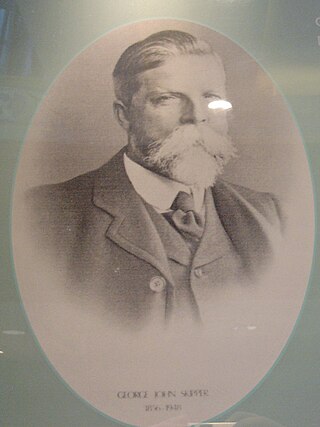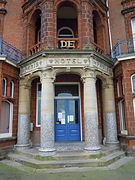
Cromer is a coastal town and civil parish on the north coast of the English county of Norfolk. It is 23 miles north of Norwich, 116 miles north-northeast of London and four miles east of Sheringham on the North Sea coastline. The local government authorities are North Norfolk District Council, whose headquarters is on Holt Road in the town, and Norfolk County Council, based in Norwich. The civil parish has an area of 4.66 km2 and at the 2011 census had a population of 7,683.

Hector Guimard was a French architect and designer, and a prominent figure of the Art Nouveau style. He achieved early fame with his design for the Castel Beranger, the first Art Nouveau apartment building in Paris, which was selected in an 1899 competition as one of the best new building facades in the city. He is best known for the glass and iron edicules or canopies, with ornamental Art Nouveau curves, which he designed to cover the entrances of the first stations of the Paris Metro.

Victor Pierre Horta was a Belgian architect and designer, and one of the founders of the Art Nouveau movement. He was a fervent admirer of the French architectural theorist Eugène Viollet-le-Duc and his Hôtel Tassel in Brussels (1892–93), often considered the first Art Nouveau house, is based on the work of Viollet-le-Duc. The curving stylized vegetal forms that Horta used in turn influenced many others, including the French architect Hector Guimard, who used it in the first Art Nouveau apartment building he designed in Paris and in the entrances he designed for the Paris Metro. He is also considered a precursor of modern architecture for his open floor plans and his innovative use of iron, steel and glass.

Fakenham is a market town and civil parish in Norfolk, England. It is situated on the River Wensum, about 25 miles north-west of Norwich. The town is at the junction of several local roads, including the A148 from King's Lynn to Cromer, the A1067 to Norwich and the A1065 to Swaffham.

The Palais-Royal is a former French royal palace located on Rue Saint-Honoré in the 1st arrondissement of Paris. The screened entrance court faces the Place du Palais-Royal, opposite the Louvre. Originally called the Palais-Cardinal, it was built for Cardinal Richelieu from about 1633 to 1639 by architect Jacques Lemercier. Richelieu bequeathed it to Louis XIII, before Louis XIV gave it to his younger brother, Philippe I, Duke of Orléans. As the succeeding Dukes of Orléans made such extensive alterations over the years, almost nothing remains of Lemercier's original design.

The Château d'Anet is a château near Dreux, in the Eure-et-Loir department in northern France, built by Philibert de l'Orme from 1547 to 1552 for Diane de Poitiers, the mistress of Henry II of France. It was built on the former château at the center of the domains of Diane's deceased husband, Louis de Brézé, seigneur d'Anet, Marshal of Normandy and Master of the Hunt.

Sloley is a village and a civil parish in the English county of Norfolk. The village is 11.9 miles (19.2 km) north-north-east of Norwich, 13.6 miles (21.9 km) south-south-east of Cromer and 128 miles (206 km) northeast of London. The village lies 4.7 miles (7.6 km) south of the town of North Walsham. Worstead railway station, on the Bittern Line between Cromer and Norwich, is about 1 km (0.62 mi) from the centre of the village. The nearest airport is Norwich International Airport. The parish had a population of 257 at the 2011 Census.

The Hôtel Biron, known initially as the Hôtel Peyrenc-de-Moras and later as the Hôtel du Maine, is an hôtel particulier located at 77 rue de Varenne, in the 7th arrondissement of Paris, that was built from 1727 to 1732, to the designs of the architect Jean Aubert. Since 1919, it has housed the Musée Rodin, dedicated to the work of Auguste Rodin.

The Hotel Le Plaza is a five-star luxury hotel in the Marais–Jacqmain Quarter of Brussels, Belgium. Built in an Art Deco style with Louis XVI interiors and opened to customers in 1930, it is one of the last independent hotels in Brussels, and also one of the oldest. It has 190 rooms and 14 spacious suites. It has served as a famous meeting place for great statesmen, artists and entertainers.

The Hôtel de Beauvais is a hôtel particulier, a kind of large townhouse of France, at 68 rue Francois-Miron, 4th arrondissement, Paris. Until 1865 rue Francois-Miron formed part of the historic rue Saint Antoine and as such was part of the ceremonial route into Paris from the east. The hotel was built by the royal architect Antoine Le Pautre for Catherine Beauvais in 1657. It is an example of eclectic French baroque architecture.

The East Norfolk Railway was a pre-grouping railway company operating a standard gauge 25 mile, mostly single track, railway running between Norwich Thorpe railway station and Cromer in the English county of Norfolk. It opened in 1874, reaching Cromer three years later, and remains mostly operational. The company also operated a branch between Wroxham and County School, which closed to passengers in 1952, and had proposed a branch to Blakeney in 1878, which was never constructed.

George John Skipper was a leading Norwich-based architect of the late Victorian and Edwardian period. Writer and poet, John Betjeman said of him "he is altogether remarkable and original. He was to Norwich what Gaudi was to Barcelona" He is regarded as an important Modern Style architect.

The Hôtel de Saint-Aignan, originally the Hôtel d'Avaux, is a 17th-century hôtel particulier, located at 71 Rue de Temple, in the 3rd arrondissement and the Marais district of Paris. It was constructed 1644–1650 to the designs of the architect Pierre Le Muet for Cardinal Mazarin's Superintendent of Finances, Claude de Mesmes, Comte d'Avaux, and later purchased by Paul de Beauvilliers, Duc de Saint-Aignan, who added the grand staircase. It is now the home of the Musée d'Art et d'Histoire du Judaïsme.

The Cliftonville Hotel is an AA 3 star Hotel, and Grade II listed building, located in the English seaside town of Cromer in the county of Norfolk, United Kingdom.

The Red Lion Hotel is an AA 4 star hotel located in the English seaside town of Cromer in the county of Norfolk, United Kingdom.

The Star Hotel is a 3 star hotel in the English town of Great Yarmouth within the county of Norfolk in the United Kingdom. The hotel has been a grade II listed building since 26 February 1998.

Edward Boardman (1833–1910) was a Norwich born architect. He succeeded John Brown as the most successful Norwich architect in the second half of the 19th century. His work included both civic and ecclesiastical buildings, in addition to private commissions. Together, with his rival, George Skipper, he produced many notable buildings with several standing to this day (2013).

The Eversley Hotel was a former hotel in the English seaside resort town of Cromer in the county of Norfolk. The hotel closed it doors shortly after the second world war and is now used as residential flats and is called Eversley Court.

The Royal Hotel is a Grade II listed building and was a former hotel located in the English city of Norwich in the county of Norfolk. The hotel closed its doors in 1977 and is now used as a business centre.

The Norfolk Hotel is a 4-star hotel in the seaside resort of Brighton, part of the English city of Brighton and Hove. Designed in 1865 by architect Horatio Nelson Goulty, it replaced an earlier building called the Norfolk Inn and is one of several large Victorian hotels along the seafront. The French Renaissance Revival-style building, recalling E.M. Barry's major London hotels, is "tall, to make a show": the development of the passenger lift a few years earlier allowed larger hotels to be built. It is a Grade II listed building.
























